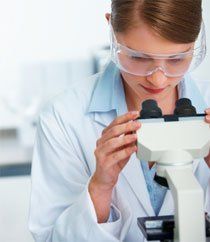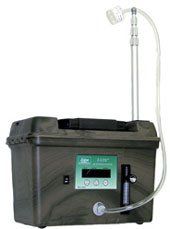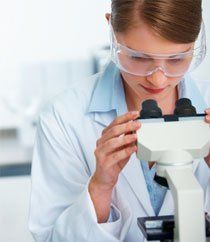Mold Testing

PowerBees utilizes air samples to gain a very precise count of the microbial organisms present in the air. Since mold is an airborne organism, this is a very effective way of gauging the overall microbial situation in any indoor space. The samples are collected using a vacuum pump system. Air passes through an AllergenCo D cassette for a set period of time, trapping all the particulates on an internal slide. Samples are analyzed via light microscopy at the standardized magnification of 600X. The results are then reported as total spores or particulates seen.

Lift Tapes
For mold testing on a specific surface, PowerBees can utilize lift tapes. A tape is lightly pressed against the face of the material, trapping spores on its surface. The tape is then analyzed via light microscopy in a similar manner as to air samples. Lift tapes are very effective for detecting Stachybotrys chartarum as it only releases airborne spores at the end of its life cycle. The rest of the time it appears as a slimy, black mold and is very difficult to detect using air sampling.
Swab Tests
A viable swab sample is collected with a sterile cotton “Q-tip” applicator that has been moistened with sterile growth media. The vial and swabbed applicator are sent to a lab for plate culturing and counting.
About Mold
Mold is a very simple microscopic organism. Two main environmental factors are required for mold to grow: moisture and organic material. Heat and oxygen become factors as well. Mold colonies can start growing on damp surfaces within 24 to 48 hours after exposure to moisture. Once they begin reproducing, mold colonies release spores that travel through the air and into other areas within the space you live, work or otherwise occupy. Indoor exposure to low levels of many mold spores is not uncommon. However, mold spores become problematic when they are present in large quantities or of a particular species, e.g., Stachybotrys. Petri Dish with MoldSuch quantities of spores and spore types can prove hazardous to humans, potentially causing allergic reactions and respiratory problems. Mold and Mildew (the same organism) grow on ceiling tiles, cardboard, wallpaper, carpets, drywall, fabric, plants, wood products, foods, insulation, and other organic materials such as dust and debris. There are certain strands of mold such as Stachybotrys chartarum which can be dangerous at any level. Such molds produce mycotoxins that can pose serious health risks to humans and animals. Some studies claim that exposure to high levels of mycotoxins can lead to neurological problems and in some cases death. Prolonged exposure at home or in the workplace can be particularly harmful.
Real Estate Transactions
When buying or selling real estate, mold is a concern for the buyer and often impacts the transaction for the seller. Buyers and Home Inspectors today are fast becoming knowledgeable about the health issues related to mold exposure. Past or present water damage are indicators that mold may be present. Visible discoloration on materials and musty odors are also signs that microbial growth may be present. Mold, as an organism, colonizes on organic matter and then germinates spores which become airborne and allow the mold to spread. Mold spores are potentially dangerous to breathe and cause various health issues. If there is a suspected mold issue in a property that is in the process of being purchased or sold, mold testing will confirm the presence of airborne mold spores and surface mold. With a higher rate of asthma and known mold allergies among both children and adults today, buyers want to understand what the air quality is like so that it can be addressed. On the other hand, sellers are often confronted with the suspicion that mold might exist and they desire to confirm that there is or is not an issue. The sellers are motivated to resolve the problem correctly so that the transaction will succeed. PowerBees can help test a property for mold to determine if remediation is required, and if so, provide a protocol on how to properly resolve the mold problem. PowerBees will help develop solutions that can bring buyers and sellers together in remediating a mold issue if one exists.There are certain strands of mold such as Stachybotrys chartarum which can be dangerous at any level. Such molds produce mycotoxins that can pose serious health risks to humans and animals. Some studies claim that exposure to high levels of mycotoxins can lead to neurological problems and in some cases death. Prolonged exposure at home or in the workplace can be particularly harmful.
Renters
If you are renting an apartment and suspect that there is an issue with the air quality or have noticed visible mold appearing on clothes, contents, in closets and on wallboard, then testing is the only effective way to confirm the presence of mold and receive documented conditions of the property with a recommended protocol on how to remediate the mold problem if one exists. The test results and reporting can be shared with your landlord in the hopes that the problem will be resolved. If there is already a dispute, testing may provide concrete evidence to support an existing mold problem. If there are health issues, mold testing might provide relief if the air quality is within acceptable tolerances or confirm that the air quality is compromised and the results can be shared with a physician.
Land Lords and Property Managers
If a tenant complains of mold, it is important that the issue be resolved so that there are no health issues. Health issues tend to cost more money to resolve than it might have cost had the mold issue been solved early on. There are often times when the airborne mold spore counts are within acceptable tolerances. Testing for mold will confirm that. There are also times when the tenant has a valid concern about the presence of mold. Mold testing will yield accurate counts and the exact mold species present and data to determine if there is fact an issue that needs to be resolved and how to solve the mold problem if in fact problematic mold is present.
Employee, students and other building occupants
Has your building had water damage in the past. Are there musty odors? Are the occupants complaining of soar throats, headaches, respiratory issues or frequent colds? Do they feel better when they’re outside of the building? Often, the air ducts provide dust and other particulates that cause these conditions. In that case, then the air ducts should be cleaned. However, if there has been past moisture intrusion or a humidity issue, there may be airborne mold within the building. Mold Testing will help identify that mold is present, provide the mold spore type and its count which is data used to determine if the mold is problematic or not. Air samples (both indoor and outdoor) as well as surfaces samples may be taken. Indoor air samples and outdoor air samples are taken. PowerBees will always compare the indoor air to out the outdoor air to determine if spores commonly associated with interior water damage and moisture are present while examining the relationship between the indoor spores and the outdoor spores. If the air quality is problematic, PowerBees will recommend a mold remediation protocol to resolve the mold issue.
WHAT OUR CLIENTS THINK
WE PROMISE, YOU'LL LOVE US TOO












